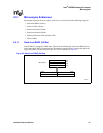
184 Hardware Reference Manual
Intel
®
IXP2800 Network Processor
Microengines
4.5.2.1 Read from RBUF
To analyze the endianness on the media-receive interface and the way in which bytes are arranged
inside RBUF, a brief introduction of how bytes are generated from the serial interface is provided
here. Pipe A denotes the serial stream of data received at the serial interface (SERDES). Bit 0 of
byte 0 comes first, followed by bit 1, etc. Pipe B converts this bit stream into byte stream
byte 0 — byte 7, etc. So, byte 0 currently is the least significant byte received. In Pipe C, before
being transmitted to the SPI-4 interface, these bytes are organized in 16-bit words in big-endian
order where byte 0 is at B[15:8] and byte 1 is at B[7:0].
When the SPI-4 interface inside the IXP2800 received these 16-bit words, they are put into RBUF
in LWBE order where longwords inside one RBUF entry are organized in little-endian order as
shown in one RBUF element in Figure 63. In the least-significant-longword, byte 0 is at a higher
address than byte 3 (therefore, big-endian). Similarly, in the most-significant-longword, byte4 is at
a higher address than byte 7 (therefore, big-endian). While transferring from RBUF to
Microengine, the least significant longword from one RBUF element is transferred first, followed
by the most significant longword into the Microengine transfer registers.
.
Figure 63. Bit, Byte, and Longword Organization in One RBUF Element
A9725-01
Pipe B
Pipe A
Pipe C
SPI-4 Bus
byte 0
RBUF Element
Offset n
byte 1
byte 2
byte 3
byte 7
{7 6 5 4 3 2 1 0}
{31 30 29 28 27 26 25 24}
{23 22 21 20 19 18 17 16}
{15 14 13 12 11 10 9 8}
B63 B31B32 B0
addr15 addr7addr8 addr0
{63 62 61 60 59 58 57 56}
byte 0
byte
4
byte
5
byte
6
byte
7
byte
0
byte
1
byte
2
byte
3
byte 0
0 1 2 3 4 5 678 57 58 59 60 61 62 63
byte 1
byte 2 byte 3
byte 4 byte 5
byte 6 byte 7


















